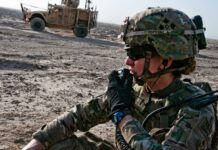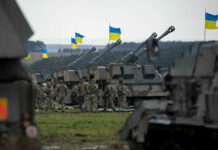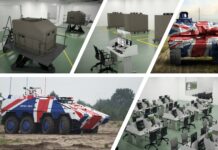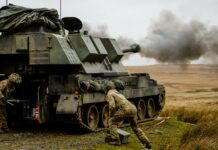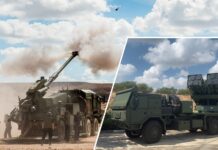Muzzle velocity radars (MVR) have been used by artillery for decades, but are still considered “exotic” when it comes to mortars. In 2019, the Danish armed forces were the first to integrate an MVR into a 120 mm mortar system (Cardom 10 from Elbit). The MVR of choice was the MVR-700 SC (Sub-Compact) from Danish radar specialist Weibel.
Weibel’s MVR-700 series was the first Doppler radar with digital signal processing and to be integrated into a self-propelled howitzer by the Swiss armed forces 30 years ago. In the meantime, over 4000 radars of the 700 series are in service with 30 armed forces worldwide, including the PzH2000 (MVR-700 C) used for Germany’s artillery. The system was presented in a more detailed manner at the Mortar Systems Conference 2020, maybe one of the last conferences this year that actually took place.
Meaning and Purpose
Internal ballistic influences are responsible for up to 70 per cent of artillery dispersion, according to Lars Krogh Vammen, Director Business Development at Weibel Scientific A/S – and former artillery officer.
Vammen said that if you want to target a combat area, then a large dispersion is certainly useful. But if you want to be able to fire more precisely at particular target, wide dispersion is more of a hindrance. This is where MVR comes into play. Using MVR makes it possible to obtain the maximum precision from an indirect firing system with conventional ammunition by eliminating several ballistic influences, Vammen assured.
Since dispersion increases with distance, the further you shoot, the more decisive the external influences become. Whereas maximum distances of six to eight kilometres were previously the standard for heavy mortars (e.g. 120 mm), several armed forces are now demanding distances beyond 10 kilometres for their future systems. In order to be able to deploy mortars at this distance with sufficient accuracy, the entire system (includes weapon and fire control systems and ammunition) must make use of every possible means of improving precision.
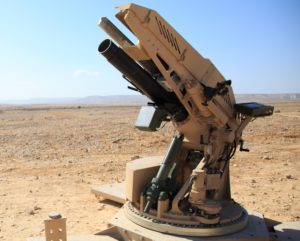
Ballistic Influences
Artillery experiences show that MVR can compensate for the following external aspects influencing ballistics (it is assumed they are at least partially transferable to mortar firing missions):
- Weapon conditions (temperature)
- Tube tolerance (wear and tear)
- Ammunition lot variation (e. g. weight)
- Propellant conditions (temperature, humidity, age, and storage conditions)
- Recoils system conditions (Maintenance and wear and tear)
- Deployment (surface, setting rounds)
Functionality
During the firing process, the Doppler radar emits a 0.5-watt pulse of approximately one second in length at up to 13 different frequencies to measure the speed of the round immediately after it leaves the barrel (muzzle velocity). As a result, the deviation of the actual value from the target value is determined.
The previously-listed factors can cause this value to deviate from the value calculated for the fire control, consequently having a negative effect on the precision of the impact on the target. Because some of the internal influences are weapon specific, theoretically four different weapon systems can produce different values of muzzle velocity when firing the same ammunition from the same lot at the same time.
Since the MVR transfers the data of the first shot to the fire control software, the measured difference is included in the subsequent shots and makes subsequent shots are significantly more precise. Weibel MVRs require little maintenance and uniquely use the shots to calibrate themselves. The measuring accuracy is specified at 0.05%. The system weight is approx. 5 kg and is already integrated in the Cardom 10 from Elbit and the Super Rapid Advanced Mortar System MK II (SRAMS MKII) from ST Engineering. Soon the integration into the ALAKran of the Spanish mortar manufacturer NTGS will be ready.
Practical Experience
Even though the Danish armed forces have yet to release any data on their experiences with the systems in operation, Vammen was able to present real test data to the expert audience attending the Mortar Systems Conference in Bristol.
For example, the MVR-700 SC was used during a series of test firings conducted by Hirtenberger Defence Europe (HDE) from 12 to 14 November 2019 at the test site of the Military Technical Test and Evaluation Institute (VTSU) in Zahorie, Slovakia. A difference of 153 meters of dispersion at a range of five kilometres was assessed. The Hirtenberger 120mm ammunition (5. charge of practice and HE bombs) were fired from the SRAMS MKII in conjunction with the arc-fire fire control system of Hirtenberger’s New Zealand subsidiary Hirtenberger Defence Technology (HDT).
In another case study, the New Zealand-based HDT used the MVR-700 SC to verify the values stored in shooting table during New Zealand armed forces firing exercise. Firing was carried out with 81-mm bi-pod mortars that are approximately 40 years old.
At a distance of 5.5 km, differences of up to 200 m from the calculated target value were detected, according to the shooting table. The results obtained were used to update the shooting tables and thus significantly increase the initial precision of the legacy systems.
Conclusion
Precision is essential for the successful deployment of mortars at multiple and different levels. The more precise the fire:
- the greater the possibility of effectively defeating an enemy
- the less ammunition is needed, both for area and point targets, achieving the same effect for less costs – or a greater effect for the same costs
- the less time is required to call up the fire for effect, reducing exposure of the mortars to potential enemy counter-fire and increasing the combat and firing units’ survivability
- the greater the acceptance and confidence of the own troops in using a weapon system in danger close situations
The Weibel MVR has evidenced potential to significantly increase the precision and performance of modern vehicle-mounted mortar systems and bipod mortars already in service. It can help to call in fire for effect more quickly, reduce unnecessary ammunition use, and achieve sufficiently accurate precision with conventional ammunition even at firing ranges beyond eight kilometres.
Waldemar Geiger




